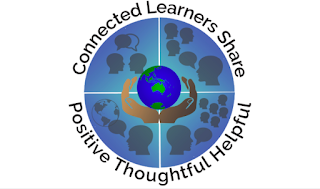Digital Fluency Intensive 4 - Dealing with Data
Digital Fluency Intensive - Data
Connecting with Manaiakalani : Share
This weeks presentation from Dorothy was the conclusion of our in depth look at the Learn, Create, Share pedagogy. Share is the final part of the puzzle which allows us to provide our learners with an authentic audience.
Share is all about being connected. Connection is part of the social fabric of human nature. We are social animals and have evolved to seek acknowledgement and reinforcement from our communities. Digital technology has allowed us to share to an enormous audience in real time.I was inspired this week by the goals of the Manaiakalani programme to provide our learners with a way to amplify their voices. Many of the students in our schools come from sectors of society who's opinions are not often sought. We turn this on its head and say to our learners - what you have to say matters and you should share that with the world. We allow the world views, aspirations, and achievements of our people to be visible and available to everyone.
Blogger allows our learners and teachers to connect in powerful ways that were not available before the digital age. "We can become the star of our own show" DJ Burt.
Dorothy shared that the choice of blogger was a deliberate decision based on a number of criteria, it functionally mimics the"trendy" spaces the kids want to be, but allows Manaiakalani to use systems to make their share experience safe, supported and systematic. Blogger also allows the learner to harness the power and reach of Google products.
I became a Manaiakalani teacher early in my teaching career and have found the visibility of other teachers practise to be invaluable. The willingness of other teachers to share their practise helped me to hone my craft and expand my idea of "publishing' of students work beyond the classroom walls.
My maps.
I was a complete My Maps novice and really enjoyed today's opportunity to play around with the features this great google app. I constructed a map of the locations visited by Pt England School on our recent Hikoi with our local iwi Ngati Paoa. I found My Maps to be a user friendly tool. It allowed me to quickly and easily attach photos and other pertinent information to the map. I think would be a great learning tool for students to engage with measurement and gain an understanding of local geography and history.
Google Forms
In the past I have used google forms as a user not an author. It was interesting to consider the many uses for google forms. I was inspired by Jeremy's example of a form he had created to collect behavioural information about a supported student. This is something I often do in my role as we support learners from ECE settings to school. Apart from the ease of using a form rather than a doc, I could see the advantage of having information uploaded from the form into a sheet. This would make it much easier to identify trends in a child's behaviour. Eg if there more issues on a Wednesday - it would allow me to consider what triggers may be occurring (perhaps PE lessons on that day might make it harder for the child to self regulate).
Google Sheets
I use google sheets alot in my daily teaching practise. I use them for planning and collating assessment data. I have used charts within my inquiry to allow me to visually represent trends. Today I learnt about using the explore tool within Sheets to quickly include suggested charts. I also found it useful to practise using conditional formatting as a way of highlighting the important data which can sometimes become lost in a large sheet.






Kia ora Deb. What a fantastic blog post. You're right about Google Forms, your behaviour data will be so much easier to handle and analyse. What a cool way to recount your Hikoi using MyMaps! It's amazing to see all these wonderful creations being shared on blogs. See you next week!
ReplyDelete